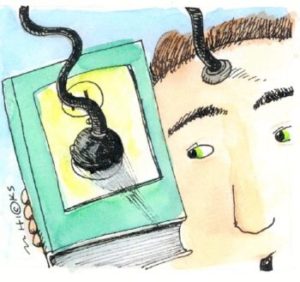Teaching Reading for Understanding

In the November/December 2016 issue of Journal of Adolescent & Adult Literacy, Goldman, Snow and Vaughn present the results of a three-year adolescent literacy project that focused on three projects that examined content literacy instructional approaches. While each project had its own model of building comprehension, all were successful in improving student outcomes.
The researchers identified three common practices found in all of the projects:
- Active, Purposeful, Engaged Reading: Having students engage with the text itself was a goal of all three projects. Instead of just learning the content through videos or lectures, activities were completed that support active, purposeful reading such as:
- establishing an explicit purpose for reading beyond answering end-of-chapter questions or passing a test
- introducing abstract or remote topics with relevant analogs so students could make connections to their own lives
- introducing and discussing new topics with videos, photos, or other sources to develop background knowledge
- Social Support for Reading Through Participation Structures: All three projects included group work (small group and whole class) where students had an opportunity to debate, discuss, and write about the text.
- Knowledge Building – Prior Knowledge and Instruction in Key Concepts and Vocabulary: All three projects introduced the vocabulary related to new content in some way that helped students make connections to their prior knowledge. Attention focused on concepts and related vocabulary critical to the subject area and topic of the text.
The authors noted that the goal for sharing the results of the study was not to promote the use of the specific materials or approaches used in the projects, but to share the content literacy instructional themes that were common to all of them so that teachers might incorporate them in their own teaching. They sum up the implications of the study for content teachers of secondary students this way:
“Instruction in reading needs to continue when students move into the content area learning and the demanding texts and tasks that confront them in middle and high school. Content area teachers cannot assume that the strategies and processes that readers acquired in the elementary grades are sufficient for students to make sense of content area materials. Instead, the three approaches discussed herein prioritize text- and discourse-based approaches to comprehension.”
Content Literacy Resources
Educators who participate in Keys to Literacy professional development for our Key Comprehension Routine, Key Vocabulary Routine, or Keys to Content Writing will see a number of instructional practices that are aligned with the three themes identified by Goldman, Snow and Vaughn. For example:
- Top-Down Topic Webs used in the comprehension routine is a helpful tool for helping students connect concepts to background knowledge, and the Word Knowledge Checklist and Semantic Mapping activity from the vocabulary routine can be used to introduce vocabulary needed to understand key concepts.
- Main Idea Skills and Two-Column Notes used in the comprehension and writing routines help engage students in active, purposeful reading.
The findings of the study support a continuing body of research that supports the teaching, modeling, and practice of content literacy instructional strategies that are embedded in the disciplinary classroom using subject-area text. This is the foundational underpinning of all Keys to Literacy professional development!

 Joan Sedita is the founder of Keys to Literacy and author of the Keys to Literacy professional development programs. She is an experienced educator, nationally recognized speaker and teacher trainer. She has worked for over 35 years in the literacy education field and has presented to thousands of teachers and related professionals at schools, colleges, clinics, and professional conferences.
Joan Sedita is the founder of Keys to Literacy and author of the Keys to Literacy professional development programs. She is an experienced educator, nationally recognized speaker and teacher trainer. She has worked for over 35 years in the literacy education field and has presented to thousands of teachers and related professionals at schools, colleges, clinics, and professional conferences.
Leave a Reply